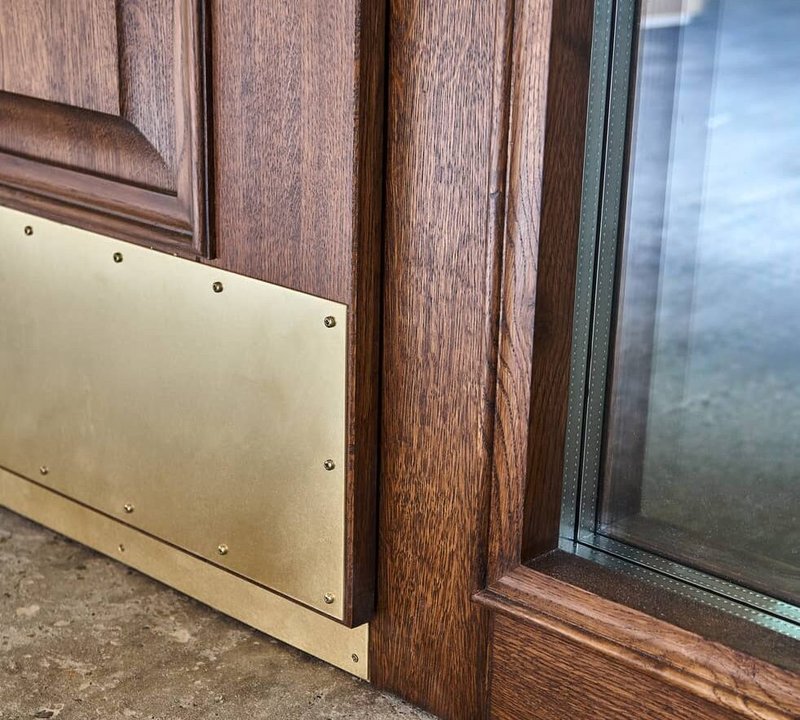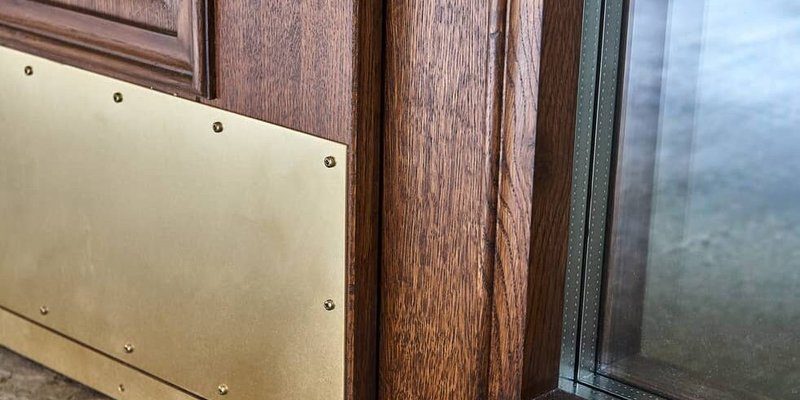
Honestly, it’s a little like having a kitchen knife lying blade-up at shin level. Nobody wants to worry about snagged pants, scratched shoes, or worse—a surprise cut. You might be wondering, “Is this a quick fix or do I need to replace the whole thing?” Before you grab the toolbox (or a pair of thick gloves), let me walk you through troubleshooting a sharp-edged kick plate step by step. This is simpler than it sounds, even if you’ve never done any home repair before.
Why Do Kick Plates End Up With Sharp Edges?
Kick plates are supposed to make life easier, so it’s kind of ironic when they become a problem. They’re usually thin pieces of metal or plastic that get screwed or stuck onto the bottom of your door. Think of them as armor for your door against scuffs, shoes, or things like rolling carts.
But here’s what happens: if the kick plate wasn’t cut cleanly at the factory, or if it gets damaged during installation, those nice protective edges can turn into little razor blades. Sometimes, cheaper models—especially from off-brand manufacturers—skip the extra step of rounding or rolling the edges. Even name-brand plates from Schlage or Emtek can get banged up if the packaging fails or someone drops the box.
You might also run into this if you’re cutting or trimming a plate to fit your own custom door. It’s easy to pay attention to the length but miss the sharpness along the cut. That’s why checking the edges before installation is always smart. If you already have a plate up, don’t worry—we’ll troubleshoot it and get it safe.
How To Check If Your Kick Plate Is Actually Dangerous
Before you start fixing anything, it’s important to figure out just *how* sharp the edges are. Sometimes, what looks dangerous is only a little rough. Other times, it really is a cut waiting to happen.
Here’s how to inspect your kick plate safely:
- Wear protective gloves. Even a thin metal edge can slice through skin with barely any pressure.
- Run your fingers gently along the entire edge. Check both the long bottom edge and the shorter vertical sides. Pay special attention to where the plate meets the door frame—this is where the worst sharp spots usually hide.
- Look for burrs, nicks, or jagged bits. These are obvious signs that something needs smoothing out.
- Test the corners. Corners are the number one spot people get snagged. If you feel a pointed edge, make note of it.
If you hear a little “zing” when your glove brushes the plate, or feel any resistance, you’ve got work to do. Sometimes, only one section is sharp—other times, the whole thing feels rough. Either way, don’t ignore it. Even one sharp spot can ruin your day.
Common Fixes For Sharp Edges On Kick Plates
Once you know where the danger zones are, there are a few ways to soften things up. Which option you choose depends on what tools you have, what the plate’s made of, and how bad the issue is.
1. Smooth With Fine Sandpaper or a File
Most mild problems can be handled with a sheet of fine-grit sandpaper (start around 220 grit) or a small metal file. Just fold the paper over the edge, and rub back and forth until the edge feels smoother. This works especially well for aluminum, brass, or stainless steel plates from brands like Schlage.
2. Use a Deburring Tool or Edge Trimmer
If there are big burrs or rough metal shavings, a handheld deburring tool is best. These aren’t expensive, and you’ll find them in any hardware store. Just run the tool along the edge while applying light pressure. It’ll strip off those jagged pieces without scratching the nice finish.
3. Add Edge Guards or Bumpers
For plastic kick plates, or if the danger is at the corners, you can buy clear rubber bumpers or adhesive edge guards. This is a great temporary fix if you rent or don’t want to replace the whole thing. Plus, it’s a bit like putting training wheels on a bike—extra protection while you figure out the next step.
The goal is to get the kick plate smooth enough that it’s safe to touch, even if you’re not wearing shoes or long pants.
When Should You Remove and Replace the Kick Plate?
Sometimes, no matter how careful you are, the edge just stays sharp. Maybe the plate was badly manufactured, or the damage is too deep to fix with sandpaper or a file. Here’s how to decide whether it’s time to swap out your kick plate:
- Deep gouges or warping: If the metal is bent out of shape, anything you do to the edge will just make the surface worse.
- Large or jagged chips: Pieces missing from the plate mean there will always be a sharp edge, no matter how much you file it down.
- Corrosion or peeling: If rust or finish is breaking away, the edge will always be rough, and it could snag clothes or skin.
Don’t worry—replacing a kick plate is straightforward. Simply unscrew or peel off the old plate, measure the door width, and find a new one that matches. If you’re using a brand-specific plate (like Schlage or Emtek), try to stick with the same brand for the best fit and finish. Universal plates work fine too, just double-check the measurements before you buy.
How To Remove And Reinstall a Door Kick Plate Safely
Let me explain how to handle removal and installation without causing more problems—or accidentally leaving sharp metal behind.
Steps to Remove the Old Kick Plate
- Gather your tools: You’ll need a screwdriver (usually Phillips), gloves, and maybe a flat tool to gently pry if there’s glue or double-sided tape.
- Unscrew or unstick the plate: Start at one end and work your way across the bottom of the door.
- Watch for hidden sharp bits: As you pull the plate off, check underneath for old adhesive or broken corners. Clean the area before adding a new one.
Steps to Install the New Kick Plate
- Line up the new plate: Use painter’s tape to temporarily hold it in place while you check alignment with the door edges.
- Screw it in gently: Don’t overtighten—the metal can warp or pop, creating new sharp edges.
- Double-check the corners: Run your gloved finger around all four sides. If anything feels rough, hit it with sandpaper before you call it done.
Take your time—this isn’t a race, and the end result should be *safer* than what you started with.
Alternatives: Kick Plate Materials and Edge Designs
You might be curious—are there kick plates out there that *never* get sharp? Or is this just something everyone has to live with? Here’s what to know about materials and designs:
- Metal Kick Plates: These are the most common (brass, aluminum, stainless steel) and look the sharpest—literally and figuratively. Some brands now offer rolled or rounded edges, which almost totally eliminate sharpness. Look for that feature on the box or online listing.
- Plastic or Vinyl: These are usually softer to the touch, and less likely to cut you. They’re not as stylish, but can be painted or trimmed at home. Great for families or rental properties.
- Edge Guards: If you want to keep your current metal plate, try adding stick-on trim—often called “u-channel molding.” These snap right over the edge and come in clear or matching colors.
If you’re buying new, ask about factory-rounded edges or safety trim. It’s a small detail, but makes a big difference *after* install.
Safety Tips When Handling Sharp Metal Kick Plates
Here’s the thing: even if you’re just doing a quick fix, working with sharp metal always calls for a little caution. Don’t make this harder on yourself than it needs to be.
Wear gloves—every time. It doesn’t matter whether you’re just checking the edge, sanding it, or installing a new plate. One slip and you could get a nasty cut.
Work slowly, and keep your workspace clean. Metal shavings or plastic bits can easily scatter, and you don’t want them ending up in your socks or shoes.
Dispose of old plates or sharp trimmings carefully. Wrap sharp bits in heavy paper or plastic before tossing them out. Don’t just drop them in your trash where someone else could get hurt.
A little common sense goes a long way, especially if you have pets or kids around. It’s better to spend an extra minute preparing than regretting it later.
What To Do If You Get Cut By a Kick Plate
Accidents happen, even with the best precautions. If you do get scratched or cut, here’s how to handle it:
Clean the cut right away. Wash it out with soap and water to remove any metal bits or dirt.
Apply pressure if it’s bleeding, then cover with a clean, dry bandage.
Watch for signs of infection. Redness, swelling, or pus means you should see a doctor—especially since metal can carry some nasty bacteria.
If the cut is deep or you haven’t had a tetanus shot in a while, don’t risk it—get medical advice. Your health is worth way more than a $20 kick plate.
Strong, safe edges on your kick plate mean you can use your door the way it’s meant to be used—without worry. It’s a fix you only have to make once, but you’ll appreciate it every day.
Wrapping Up: A Smooth Edge Is Worth the Effort
Troubleshooting a kick plate that has sharp edges isn’t rocket science, but it does make your home safer and a little more comfortable. Whether you’re dealing with a fancy Schlage metal plate or a simple universal model, smoothing out those edges is a project you can handle in an afternoon—with just a few tools and some patience.
Remember, don’t settle for a kick plate that bites back. Whether you’re sanding, replacing, or upgrading, the goal is always the same: a smooth, safe door that works for everyone who uses it. With the right approach, you can fix this once and forget about it. Now you can focus on what doors are *really* for—welcoming people in, not cutting them on the way through.
